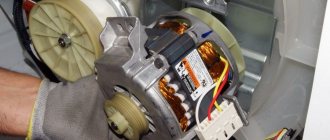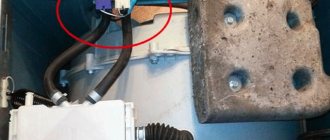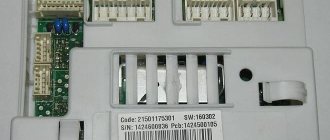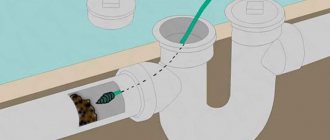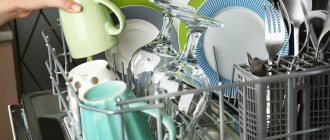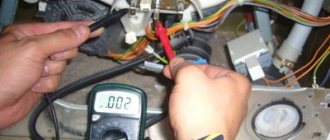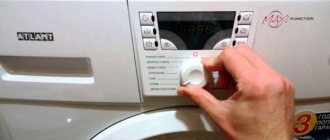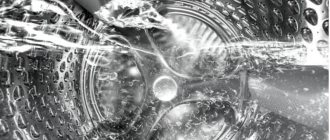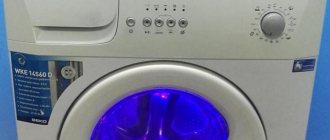It is worth noting that a breakdown of the inlet valve and some other reasons also contribute to the constant intake of water. While the machine is washing, it repeatedly draws and drains water during one cycle, but this should not happen continuously throughout the wash. Here the reason lies either in its incorrect installation or in the presence of a malfunction. It is highly not recommended to operate such a machine - this can lead to more serious damage and flooding of neighbors.
First of all, you should check the connection to the sewer pipe. If the drain hose is located below the tank, the module recognizes this as a lack of water when filling, which is why it is topped up. The next filling occurs in the same way. This washing cycle is called “siphon effect”.
Checking the correct connection
It is worth understanding that the correct position of the drain hose is above the tank. From the floor to the connection with the siphon or sewer pipe, the distance should vary from 50 to 60 centimeters. This must be taken into account when connecting.
However, it is not possible to check this in all cases due to its inaccessibility. A cabinet or “screen” on the bathroom may interfere.
In this case, you should perform the following algorithm of actions:
- Start the program (you can quickly wash).
- Wait until the tank is filled with water.
- Enable drain mode.
- As soon as the water begins to decrease, press pause, and if at this moment the water remains at the same level, then the machine is connected correctly.
- If there is a characteristic sound indicating a drain, or visualization of a decrease in the water level, it is recommended to postpone the wash and seek help from a specialist.
Why does the washing machine fill with water and immediately drain it?
If a malfunction in the water supply is detected immediately after installation, then the connection of the machine to the sewer system is incorrect. Other reasons include:
- Damage to the electronic control module.
- Malfunction of the electronic control unit.
- Washer tank leaking.
- Inlet valve is faulty.
- Problem with the water level sensor, pressure switch.
- Blockage in the drainage system or sewer system.
Malfunction of the inlet (filler, inlet) valve
The inlet valve supplies water to the tank. The failed part does not shut off the water, the tank is filled completely, and the machine immediately drains without washing. If the valve has a weak membrane, water will leak out even when closed. You will be able to see the leak under the car.
Hoping that the problem will go away on its own is futile. You need to immediately call a technician to your home. Often, an experienced technician will replace the valve.
Malfunction of the pressure switch - water level sensor
The pressure switch is the most important element of an automatic washing machine; it determines the amount of water in the tank and sends a command to the fill valve to supply water. The fullness of the tank is determined by the pressure of the water column. The sensor's filling tube becomes clogged with small debris and scale and stops working correctly, providing deliberately false information about how much liquid is in the drum. The blockage is most often created in the hoses and valves of the sensor. If the water level sensor breaks down, the part produces incorrect data and therefore constantly pours water. It is not so easy to independently check the performance of a part. Professional assistance is required in diagnosing, repairing or replacing a spare part.
Our service center has formed its own warehouse of necessary spare parts. Therefore, we are always ready to make urgent repairs to your home assistant. We use only proven original spare parts from official manufacturers. That is why we provide a guarantee on the work of the master and components.
Washing machine tank leaking
Have you noticed that your washing machine tank is leaking water? Let's figure out the problem. First of all, there may be a crack in the tank. This happens if, before washing, users forget to empty their pockets and metal parts: coins, tokens could get into the small space between the drum and the tank of the machine. Service technicians recommend immediate replacement of the tank. Although many limit themselves to using moisture-resistant glue, the machine allows water to pass through again.
Another reason for a leak: the gasket between the two halves of the washing machine tank has dried out and leaked. It is necessary to replace the element, it is better to call a specialist, since the machine will have to be completely disassembled. If the machine has a solid tank, this cannot happen.
Incorrect connection of the washing machine
When connected correctly, the drain hose is located above the tank: it is attached to the siphon or directly to the sewer pipe, to a height of 60 cm from the floor. Have you recently connected the machine, but is it constantly filling with water? We check at what height the drain is located.
It happens that it is not possible to examine the connection location because of the wall or screen. Then you can do a simple test. When draining the water during the rinse process, press pause. If the water continues to decrease, then the problem is with the installation of the machine. Don't put off calling a technician until later. The machine may malfunction.
Damage to the control unit (electronic module)
The reason why the washing machine does not hold water is a malfunction of the electronic control unit, which is responsible for the operation of many components of the machine, including the pressure switch, pump, heating element and other elements. If the firmware has failed, then it is possible to launch the fill and drain functions simultaneously. An electronic display that displays an error code helps to recognize a breakdown. A malfunction of the electronic module is one of the most common breakdowns of washing machines of the Candy, LG, and Ardo brands. This is the most essential part of the machine; you should approach the repair responsibly and call a professional technician. After all, the cost of a new control unit is quite high, but a specialist can restore the original control unit.
Blockages
Clogging is one of the most common causes of washing machine failure. Over time, the filters become clogged and scale forms on them. Filters are divided into two types: drainage and inlet.
Note. Input filters break down especially often in machines.
Signs of blockages in the filter:
- unpleasant odor emanating from the device;
- slowly collecting water and draining it.
Step-by-step cleaning plan:
- input filter:
- turn off the water supply tap to the washing machine;
- disconnect and pull out the hose;
- pull out the filter;
- rinse the filter under strong water pressure;
- Insert the clean filter mesh back and press it along the edges;
- assemble the system and check for leaks.
- drain filter:
- open the lower hatch on the front panel;
- disconnect the hose;
- place the container and drain the remaining water;
- Pull out the filter in a circular motion;
- rinse the filter under running water;
- install the part back;
- turn the machine on to the “drain” mode and check for leaks.
To prevent blockages, you should clean the filters at least once every 2–3 months. The dirt trap socket, as well as the place where the filters are installed, must also be cleaned. Such simple care can extend the life of the machine for many years.
First aid in case of lack of water supply
- Check that the tap through which the water is supplied is open.
- If it was open, then you need to close it. Then disconnect the water supply hose (it is located at the back of the machine) and lower it into a plastic container. Water will pour out of it.
- Check to see if the hose is kinked and straighten the kinks along its entire length.
- Unscrew the hose from the washing machine.
- A valve system appears before us, into which a mesh filter is inserted. The filter has a special indentation, so we take pliers and, grasping this indentation, pull out (do not unscrew) the filter mesh.
- The mesh can be cleaned with a needle under water pressure and inserted into the valve using pliers.
Why is it better to contact a specialist?
The main disadvantage of constantly draining and collecting water is the complete washing out of the powder and other products. In this case, the machine does not remove dirt. In addition, during such work, the tubular electric heater experiences extreme load, since it is constantly trying to heat the water that has just been poured into the tank. The result is a corresponding error displayed on the screen, breakdown of the heating element and expensive repairs.
Of course, the correct connection diagram is contained in the instructions for the machine. Anyone can figure it out, but the correct connection will need to be checked without fail.
Independent work will not give a positive result in all cases. Often, lack of experience leads to even more serious malfunctions. The craftsmen have both experience and special equipment. In a short period of time, they connect the machine by moving the hose to the correct position or installing an anti-siphon valve. It is installed in exceptional cases, since it requires periodic cleaning.
Possible violations of operating rules
Sometimes the reason for washing without spinning can be caused by simple inattention.
Wrong washing program selected
In this situation, the spin cycle does not work in the appliance. But rushing to wring out wet things with your hands is not an option. It is better to read the instructions more carefully. Not every washing program requires a spin cycle. Sometimes the laundry is spun at low drum speeds, or the wash cycle ends with a rinse. Then the water drains from the car, but the things inside remain wet. If, after opening the hatch door, the presence of water in the tank is detected, you need to check how the program options are set. Perhaps spinning is not intended initially. For example, if a gentle mode is selected for items made from delicate types of fabrics, and so on. The problem is not such, since everything will be fixed by resetting the regulator to the desired function.
But it also happens that the spin cycle is simply accidentally turned off by one of the household members. To spin out the washed items in this case, you just need to reset the regulator to the “Spin” option and start the process using the “Start” button. The number of revolutions on the regulator is not set - also one of the banal reasons for the spin failure. At the zero mark, the machine does not provide for spinning the laundry. The water will simply drain out and the cycle will end.
Uneven distribution of laundry
This is what upsets the balance of the washing machine. Models with a display report a balancing problem with the information code UE or E4. In other devices, the washing process simply stops at the spin stage, and all indicators light up simultaneously. Often, when there is an imbalance, the laundry in the drum gets bunched up. Incorrect loading of bedding also causes a program failure. For example, when they were stacked in a tank. To eliminate the imbalance, it is enough to manually distribute the laundry evenly.
Drum overload
Eliminating weight overload is the easiest thing to do. You just have to remove some of the laundry from the washing machine. Or try to redistribute things and restart the “Spin” function. Exceeding the maximum permitted weight poses a danger to the device, therefore, in case of such a violation, an error code is displayed on the display or the entire process stops. The situation can be easily resolved by turning off the power and removing some of the items from the washing tank. To prevent the drum from overloading in the future, you need to load laundry according to the operating instructions
It is important to take into account the fact that wet clothes become heavier, so maximum load is undesirable
Imbalance and overload are equally unsafe for washing machines. The automation stops operation before the start of the most active phase of washing - spinning at high speeds.
Incorrect or broken hose
The reason why the machine fills and drains water at the same time is that the hose is incorrectly positioned, broken or too low. In this case, the display shows an error code: LE, LC, E9, or LE1.
Such codes are deciphered as “self-draining”, “leakage”. If the machine is not equipped with a display, all wash indicators turn red, except for the cold mode. In devices equipped with an aquastop, a special “float” in the pan reacts to a leak, which immediately gives a signal to stop work.
It is possible that the connection between the hose and the sewer is not secure enough, especially if it has recently been unscrewed. The gasket may be worn out and needs to be replaced.
If such a problem occurs, it is necessary to inspect the floor for the presence of puddles, as well as the hose itself and the place where it is attached to the drain point.
Advice! Before washing, you should carefully inspect items for sharp objects. A small nail or pin in the pocket may fall out and damage the hose when draining.
Errors also occur when too much foam forms in the drum. The reasons are as follows:
- low-quality washing powder;
- overdose of detergent;
- powder not suitable for automatic machine.
The pressure switch reacts to this by displaying an error code.
Attention! If erroneous codes are displayed on the display of a new, newly connected machine, the issue is often resolved by a simple reboot.
Why doesn't the tank hold water?
There are several reasons why a washing machine immediately drains water after filling. The simplest and most easily removable:
The device is not connected to the sewer correctly. If the drain hose is below a certain height (for LG and Hansa it is 50 cm, for Candy and Indesit 60 cm), the flow of water, according to the laws of physics, will constantly flow into the drain automatically. To avoid this, check that the drain is connected to the system correctly. If you find errors, invite a specialist.
There is a blockage in the drain. Because of this, the pressure in the drain pipes increases, and the contents of the drum simply begin to be drawn into them. This breakdown is especially common in old houses, where the sewer lines are outdated, covered with plaque and easily become clogged. You can eliminate the problem by cleaning the pipes
Please note that you cannot continue washing when clogged, despite the fact that the machine quickly draws water back; in this situation, the heating element is loaded too much and may burn out.
Other reasons are due to breakdowns of the internal parts of the washing machine. You need to understand them in more detail to understand how to act.
Set valve stuck
One of the most vulnerable parts is located next to the inlet hose and is responsible for promptly opening or closing the flow from the water supply to the drum. If the intake valve breaks, it continuously pours water into the system, and the device immediately drains it. To find out if this is really the problem, stop the wash and set the drain mode, then press pause and listen. If water continues to flow, the valve has stopped working properly.
If the service center offers you to repair this part, it is better not to agree to it. Technologists from the Ardo and Whirlpool factories claim that any damage to the intake valve is irreversible. It is recommended to install an original spare part.
The water level sensor is faulty
The pressure switch is located closest to the washing tank. It checks how full the tank is and transmits this information to the control unit. If the high pressure tube gives a signal that there is not enough liquid, the device begins to draw it to the required level. If this sensor fails, it will not detect that the drum is full, and the security system will drain the excess.
A professional technician with extensive experience can find out that the problem is in the pressure switch. He must replace this part. Although sometimes you can restore its functionality by sealing the tube.
Drain valve does not work
In some cases, when washing in an automatic machine, a siphon effect may occur. This is the dependence of water flow on pressure in the sewer. Sometimes dirty liquid from the drain can enter the tank of the device or flow out of it uncontrollably. To prevent this from happening, a check valve is installed on the drain channel. It simultaneously protects the drum from leakage and protects the system from dangerous pressure drops.
If the anti-siphon is damaged, it will not work correctly and in some cases can cause continuous drainage into the drain. To fix this, ideally you need to replace it, but before you buy a replacement, try cleaning the filter in the valve or get a professional to do it for you.
Control module error
If all previous reasons are excluded, and the washing machine takes in water and drains it immediately after filling, it means that a failure has occurred in the control unit of the device. It controls all processes and processes all signals from other elements.
If the contacts of the control board are oxidized, foam or moisture gets in, a short circuit or any other damage occurs, it is impossible to predict how this device will behave. It can be extremely difficult to repair, although some repairmen offer such services. Manufacturers Miele and AEG strongly recommend replacing it at the first suspicion of a module defect. Otherwise, the system will not be completely safe from errors.
Online diagnostics of a washing machine
If your machine stops washing or rinsing clothes normally, then some kind of malfunction or breakdown has occurred. You can try to find the problem yourself.
Select which operation your washing machine does not perform:
1. Doesn’t drain 2. The drum does not rotate3. Doesn't wring out laundry4. Noisy, knocking, buzzing when spinning5. Doesn't turn on
Checking the operation of the drain pump Is the drain pump of the washing machine working?YesNoI don’t know << Back
Clogged hoses in the washing machine If the sound corresponds to the normal sound that has always been observed when the device is working, the cause is probably a clog.
Was there a blockage in the drain hose?Yes
<< Back
The drain pump does not work! If the sound matches the normal sound of the drain pump, it is recommended that you check the drain filter first.
After cleaning, the drain pump works and the washing machine drains water?YesNo
<< Back
Operation of the drain pump The sound of the pump is usually immediately audible and noticeable. If there is no sound, the pump is not working. We are looking for how to separately enable the water drainage program. As a rule, this is a separate option. After the program has been turned on, the pump should start working in 1-3 seconds. If everything is done correctly and the pump is operational, a buzzing sound will appear. If you hear no buzzing or other sounds when you turn on the program, the pump is probably faulty.
Is the washing machine drain pump working?YesNo
<< Back
Clogged car hoses If you have identified a clog in the hoses, you need to disassemble them, clean them, and then reassemble everything.
Does the washing machine drain well?YesNo
<< Back
Hurray, you did a great job, you fixed it.
<< Return to the beginning of diagnostics
The drain pump is faulty, call a professional.
<< Return to the beginning of the diagnosis.
The washing machine does not rotate the drum. During the operation of the washing machine, such a problem may occur. Each model has a different drum operation. It rotates according to a given algorithm, which is set by the program. This principle applies to spinning and washing. If you are not sure whether the drum is not spinning or whether it is working, put the laundry in the washing machine. Start the spin program. If the machine is running, it will first drain the water and then start spinning. In this case, a rotational process will be observed. If rotation is not visible, then check the belt. First, turn off the program, then unplug the wire from the outlet so that power does not flow into the device. Now you need to remove the back cover. You will need to carefully inspect the drum belt. It is quite easy to determine whether it is in the wrong position or damaged.
Is the washing machine belt torn or stretched?YesNo
<< Back
Broken drum drive belt If the belt breaks, it will be immediately visible. There are also often cases when the belt simply stretches, which is why the drum, accordingly, does not rotate. Do not allow the machine to operate if the belt breaks. It is important to check whether it has wound around the engine pulley or broken the wiring to the engine. The heating element and temperature sensor may also be damaged if the belt does catch the wires. It is imperative to ensure that the belt model is original. If you choose an unsuitable or low-quality product, this will affect the performance of other devices. How do you know what kind of belt you have? There will be a marking written on the old one, compare it with the one indicated on the belt offered to you. You can also find out belt information by car model.
READ MORE: Rating of the best BBK TVs of 2021 (TOP 10)
<< Return to the beginning of the diagnosis.
Washing machine motor malfunction If a malfunction is not found, the block with wires must be disconnected from the electric motor. Carefully remove it. We visually evaluate the engine. It may have melting, cracks, or other effects that clearly indicate damage. We call the windings of the tachogenerator and the engine. It is important to understand that you can fully study how correctly the engine operates and whether there is a malfunction only at the stand. If rotation does not occur, there may be a problem with more than just the motor. Sometimes the cause is a malfunctioning electronic module. If a short circuit occurs in the engine, the module could be damaged, while the engine remains operational. Also, the wires could be damaged.
<< Return to the beginning of the diagnosis.
Repairing a washing machine that does not spin clothes After completing the washing process, the washing machine may not spin properly or may not start spinning. Firstly, look, perhaps another mode is set, which does not involve turning on the spin cycle at all. This happens, for example, with programs related to washing woolen items and delicate fabrics. To check, run the spin cycle separately. If the washing machine does not drain water, we proceed to check the pump.
Does the washing machine now spin clothes?YesNo
<< Back
Congratulations, you have solved your problem!
<< Return to the beginning of the diagnosis.
Repair of washing machines, imbalance Modern washing machines place the laundry on the drum before spinning. This is necessary for quality work. Check if this feature works. Sometimes a situation occurs when things get wrapped up in a ball that cannot be unwound automatically within a certain time. At this point the work stops. You need to unwind this laundry yourself, lay it out and continue operating the washing machine. In this case, it is important to turn off the machine, and then, when the laundry is laid out, turn on a separate spin program.
Does the washing machine now spin clothes?YesNo
<< Back
Washing machine repair, drum drive repair Now you need to check the drum drive belt. We remove the cover and visually assess the condition of the belt. There should be no damage. If the tension is weak, the spin may not turn on. If you need to replace the belt, you should only replace it with the original one. After replacing, we try the program again.
Fault found, does the washing machine spin?YesNo
<< Back
The engine or electronic module is faulty, call a repairman to your home.
<< Return to the beginning of the diagnosis.
The washing machine hums, makes noise during the spin cycle, rumbles, and makes a jet plane noise. If the washing machine makes noise during operation, making unusual sounds, it’s time to pay special attention to it. In this case, a visible breakdown or lack of functionality may not be observed, but the appearance of strange sounds indicates that it is time to look for a malfunction. It is important to understand that a new car that has just been delivered should be inspected for shipping bolts. If you forget to remove them, noise and vibration are inevitable. So, let's begin! We turn the washing machine drum and listen to extraneous sounds.
When rotating, is there any extraneous noise, hum, balls rolling, does the drum move unevenly with slight jamming?YesNo
<< Back
If the drum rotates and uncharacteristic sounds appear, including vibration, it’s time to check the bearings. If they malfunction, they will have to be replaced.
<< Return to the beginning of the diagnosis.
The counterweight of the washing machine has come loose. The fastening of the counterweights must also be of high quality. If they are “loose”, it’s time to eliminate this defect. In some cases, you can notice that the bolts that secure the stones are completely missing. In this case, the connectors for mounting will be visible. The bolts need to be found and put in place - they probably simply came loose. A rumble heard while the washing machine is operating may indicate that the bolts have partially loosened. To check the bolts, you can simply push the drum. If it is secure, the bolts are fine. If it moves, there is a defect.
Do you hear any noise, clanging or rattling noises when moving the washing machine tub?YesNo
<< Back
The counterweight has come off
<< Return to the beginning of diagnostics
Checking the shock absorbers of the washing machine Checking the shock absorbers. If you hear vibration or excessive noise during the spin cycle, there may be a problem with the shock absorbers. Sometimes the washer moves. Now let's check the functionality. Remove the top cover. Click on the tank, move it five to seven centimeters down. A normal reaction will be observed if the tank rises sharply, jumping a little and stopping in its normal place. If this does not happen, the shock absorbers need to be replaced.
Are the washing machine shock absorbers working?YesNo
<< Back
If a visible defect has not been identified, check whether a foreign object may have entered the machine. Replacing shock absorbers. The problem with shock absorbers wearing out occurs quite often over time.
<< Return to the beginning of the diagnosis.
Replacing washing machine shock absorbers. Malfunction and wear of shock absorbers is a fairly common phenomenon.
<< Return to the beginning of the diagnosis.
The washing machine does not turn on. It is worth trying to find the cause of the problem yourself and fix it. We start by connecting the device to the network. Next, click on the “network” button. In different car models, different indications are triggered: here either the display will start working, or, on the contrary, some other button.
Does the washing machine have an indication?YesNo
<< Back
Hatch lock lock (UBL) You can check it by turning on any of the programs. We choose what we will use. Click on the corresponding button. Don't forget to pay attention to the inclusion. As a rule, the process of activating a function is characterized by the presence of a certain sound, for example a click, with which the device makes it clear that pressing again is not necessary and the machine is already working. If there is no sound, the button may be broken. In this case, the main thing that must be done is to block the hatch and start working. If this happens, everything is fine.
READ MORE: 16 reviews of Mattress Dimax Optima Premium 3, 90x200 cm from OZON customers
The washing machine is blocking the hatch, the UBL is triggered?YesNo
<< Back
Water fill valve malfunction
<< Return to the beginning of the diagnosis.
The washing machine hatch does not lock
<< Return to the beginning of the diagnosis.
No indication Checking the electrical circuit. If you notice that the washing machine does not respond to being turned on, it is first recommended to check the power supply. The outlet may be faulty. Try connecting another device. If the outlet works, you need to check whether the circuit that conducts energy through the washing machine from one element to another is intact. To do this, you will need a multimeter, which will help you fully analyze the ability to respond to an electrical signal at several stages of operation. If there is no network connection anywhere, this is probably the problem. We carry out this manipulation until we reach the electronic module. If we are talking about an old washing machine, here it will look like the device’s program. When you turn on the button, there should be no breaks in the circuit. If the circuit works, everything is fine electrically.
Is the washing machine's power supply OK?YesNo
<< Back
Repair of electronic module (unit)
<< Return to the beginning of diagnostics
Contact circuit fault
<< Return to the beginning of diagnostics
What it is not recommended to do on your own
Let's consider situations where the reason is clear, but you cannot do without the help of a specialist. Fixing the problem yourself can lead to undesirable consequences.
Trying to fix a broken intake or exhaust valve
The inlet (inlet) valve is a device necessary for the dosed supply of water into the tank. When voltage is applied to the coil, an electromagnetic field is generated. It acts on the magnetic rod, drawing it into the coil. At the same time, the membrane opens and water flows into the outlet fitting of the valve. From there, the liquid medium penetrates into the washing machine tank. After it is filled, the power to the coil is turned off, and the membrane takes its original position, blocking the access of water.
You can determine that the problem is in this block in the following ways:
- Check the valve mesh. If necessary, it can be cleaned. If there is a blockage in this place, the washing machine will either not fill the water or the tank will fill slowly.
- If the valve does not open, you need to check the coil. There was probably a burnout. With this malfunction, water will not flow during one of the washing modes.
The pressed-in plastic inserts in the fittings are also subject to inspection. They are responsible for reducing the water supply. If the inserts fall out, the amount of water passing through increases. This valve needs to be replaced.
Replace the pressure switch - water level sensor
The part, which is a sensor for determining the water level in the drum, sends signals to the control module. A malfunction of the pressure switch is quite easy to notice. The machine starts the washing program without adding water. Another situation is that the drum picks up too much or too little liquid. The rinsing and spinning stages are disrupted. A broken sensor may also be indicated by a lack of drainage.
Troubleshoot a tank leak
If the tank is leaking, there may be 2 reasons:
- the tank body is cracked;
- damage to the joints of parts.
It is useless to try to fix cracks yourself with waterproof glue: the result will not last long. Therefore, the tank will have to be replaced or another gasket placed at the junction of the parts.
Replace the electronic control module
One of the most common malfunctions is related to the electronic unit. No well-known brand is immune to this problem. The electronic module is responsible for thermal indication, water level, displays information on the operation of the device on the display, and is responsible for the washing and rinsing speed. Such breakdowns require replacement of the element.
Replace belt
If the drum rotates very slowly during washing, with scraping sounds, or does not rotate at all, an error code appears on the display, most likely the drive element is damaged. If the belt breaks, it can break the wiring or damage the sensors. The causes of this problem can be either improper operation of the machine or wear and tear over its service life. Moreover, narrow washers, as a rule, wear out faster due to the close arrangement of parts.
Pressostat malfunction
The washing machine fills an incomplete tank of water and immediately starts draining; the washing process does not start. The reason may lie in the closure of the pressure switch - a water level sensor that shows its quantity in the tank. Its breakdown can be determined by the following typical signs:
- water is constantly pumped into the drum;
- water level too high or too low;
- laundry is not wrung out properly;
- There is always a puddle of water at the bottom of the drum.
If the device gives an error without even starting the wash, the pressure switch may also be to blame: the tube is clogged and needs to be blown out.
By default, the pressure switch has three positions:
- full tank;
- empty tank;
- overflow
When you turn on the machine, the water supply valve starts, and the pressure switch, due to its malfunction, detects an overflow. After this, the upper part of the terminal closes and the water begins to drain. Upon subsequent switching on, the incorrect cycle is repeated. The solution is to replace the pressure switch. For this procedure, you must have the skill to use a screwdriver and pliers.
Important to remember! Each manufacturer of washing machines produces its own type of pressure switch. A sensor for “Samsung” will not fit “LG”, so the part is always replaced with a similar one or one recommended by the company.
Surgical method or second aid to washing machine
We take all precautions by turning off the water and unplugging the washing machine. In the first step, we disconnect the hoses from the valves (which are located at the back of the machine), since water often remains in the hoses, you need to prepare a container to drain it.
- Unscrew the fastenings of the top cover of the washing machine.
- The wire connectors from the coil tend to have bright colors (like blue and red), similar to blockbusters, you need to remember their location and disconnect them.
- Using pliers, remove the fasteners from each of the four hoses.
- Note the location of the hoses and disconnect them. Keep in mind that they may also contain water, so it's best to have a towel ready.
- We unscrew the screw that secures the valve (it is located at the back) and take out the inlet valve itself.
- We install a new water supply valve by placing it in the bracket and securing it with a screw using a screwdriver.
- We attach the hoses to the connectors and secure them with clamps. Connect the coil wires.
- Reinstall the cover of the washing machine, giving it its original position, and secure the cover with screws behind the machine. We connect the hoses to the new inlet valve.
- We connect the water and plug in the washing machine and check its functionality.
- Open the back cover of the washing machine.
- A temperature sensor and a grounding terminal are connected to the heating element. To remove these wires, use pliers and pull out the connectors.
- And then we take a socket wrench and unscrew the nut that holds the heating element.
- Then use a screwdriver, and then with your hands, using up and down movements, pull the heating element towards you, and together with the heating element you need to pull out the rubber seal.
A screwdriver will help here again.
When we insert a new heating element, you must pay attention to its guide, that is, look into the hole formed from the previous heating element. There will be grooves for the part to fit tightly.
It is best to lubricate the rubber seal of the new heating element with dishwashing gel before inserting it so that it can be inserted easily and quickly.
Then we insert the temperature sensor, tighten the nut and connect the wires.
Causes of malfunction
When a washing machine breaks down, water can come from both the sewer and the water supply. You can tell by the color and smell; if cloudy water slowly appears in the drum, then this is clearly water from the sewer.
At the same time, when the machine draws water from the water supply without stopping, the Aquastop system will not save you from overfilling the drum with water. The leakage protection sensor is fixed in the washing machine tray, and water will leak onto the floor. Therefore, even the most advanced protection will be powerless in this case.
But what is the reason that the machine takes on water? There are two reasons:
- water supply valve malfunction;
- malfunction of the siphon valve or its absence;
- the drain system is clogged, causing water to flow back into the drum through the drain hose.
Troubleshooting
So, when you see that the switched off washing machine is drawing water, immediately turn off the water supply tap. Only then proceed to troubleshooting. Do not forget to disconnect the machine from the power supply. If the reason for the water intake is the solenoid valve, then it must be replaced with a similar one. It's not difficult to do this yourself.
Getting to the filling solenoid valve is easy. In front-loading machines, it is located under the top cover of the housing, and this is what needs to be removed. In vertical machines you will have to remove the side cover. But first, turn the machine around so that it is convenient to work, and disconnect the water supply hose. Having seen the valve, disconnect the hoses from it, loosening the clamps, and the electrical wires, remembering the polarity of these wires. Unscrew the valve from the machine body and remove it.
Since solenoid valves cannot be repaired, we take a new spare part and connect it to the hoses. At the same time, we use new clamps to ensure reliable connections. Then, observing the polarity, we connect the electrical wires and fix the fill valve.
Before closing the lid of the washing machine, connect the inlet hose and run a test wash. Check connections for leaks. Once you are sure everything is in order, reassemble the machine and set it in place.
If the drum collects water from the sewer, then first clean the siphon to which the drain hose from the washing machine is connected. Well, if the reason is the connection to the drain, then read the article Siphon for a washing machine.
Precautionary measures
And finally, how to avoid situations where the machine is turned off and takes on water. Everything is quite simple, you need:
- After washing, close the water supply tap; if it is not there, be sure to install it.
- Connect an anti-siphon valve, which will prevent waste water from flowing back into the machine.
- Use a leakage protection system that is installed on the floor. As we noted, the washing machine’s protection system will not help in such a situation.
We hope the information in this article will help you prevent a flood, find the reason why water appears in the drum and quickly eliminate it. Good luck!
Intake valve failure
The inlet valve is a device that automatically controls the flow of water into the washing machine. Therefore, if it stops taking in water, it could mean the inlet valve is broken.
Intake valves are divided into several types:
- single-section (found in old-style devices);
- double;
- triples.
The latest types of valves are installed in electronically controlled machines.
A failed valve cannot be repaired and must be replaced with a new one. Before replacing, you should check it for blockages or using a multimeter. The resistance of the working valve will be 2–4 kOhm.
Diagnostics
If breakdowns occur related to draining waste liquid in the washing machine, owners can launch the self-diagnosis function of household appliances. Many models of machines have a similar function, thanks to which the equipment will independently calculate the reason for the malfunction and display it on the information display.
The self-diagnosis function is not provided in all washing machine models. In this case, the owners can independently conduct a kind of revision of the device to find the cause of the malfunction. Let's look at how this can be done.
- First of all, you need to understand that all diagnostic manipulations are allowed to be performed only with the machine disconnected from the network. Try not to forget about this.
- First, you should check the correctness of the set washing program if water accumulates in the drum. As mentioned above, the “Night” or “Hand” washing modes can lead to similar consequences. In such a situation, it is enough to cancel the program and start the drain.
- Carefully inspect the drain hose of the device. The blockage could have formed due to the hose being kinked somewhere. Because of this, excess waste simply cannot go down the drain.
- The siphon could also become clogged if the device is connected through it. To check this, you can disconnect the hose and redirect it to the sink, then start the draining process. If you notice that liquid flows freely from the hose, then the reason lies in the sewer. It is enough to clean it using specialized means or calling a plumber.
If you have completed all of the above steps to diagnose the equipment, but it still does not drain the waste liquid completely (or at all), you can try to restart the device. Disconnect it from the electrical network, let it stand turned off for 15-20 minutes, and then run the program responsible for draining again.
We look at the control module
If the error code displayed indicates problems with the control board, then things are bad. The electronics of Indesit models have long been recognized as weak and unreliable, so the probability is high. But it is better to first reboot the machine to prevent accidental system failure. If after restarting 15-20 minutes later the situation repeats, diagnostics are needed.
Repairing or flashing a board with your own hands is risky and very difficult. It’s better not to experiment and call specialists.
Interesting:
- Why does my LG washing machine fill with water and immediately drain?
- The washing machine stops during the washing process
- Electrolux washing machine does not drain water
- Why does my washing machine constantly drain water?
- The washing machine does not spin or drain water - what to do?
- Bosch washing machine makes noise during spin cycle
Reader comments
- Share your opinion - leave a comment
Program control problems
A malfunction of the electronic module is indicated on the display of the technical device in the form of an error code. This code tells you where to look for a breakdown. It makes sense to restart the program and turn on the washing machine again. If simultaneous draining and filling continues, professional assistance will be required.
With Zanussi devices, it happens that when water is drawn, after 15–20 seconds it begins to be discharged, and the lights on the display blink. In this case, check:
- a heating element;
- motor contacts or winding breakdown;
- control module electronic board;
- pressure switch;
- brushes on the rotor (extreme wear).
To clarify, the check is done step by step: the drum is turned, the temperature is monitored, and the filling is performed. Deciphering error codes will help to correctly determine the cause of self-draining.
Incorrect sewer connection
Such a malfunction causes constant drainage of water and occurs both in a newly installed washing machine and in a washing machine that has been working properly for many years. The problem is that the drain hose is located below the level of the tank, because of this the liquid is not retained, but is constantly drained into the sewer. The machine steadily replenishes lost water. The liquid in the tank does not have time to heat up, so the heating element works constantly, which can lead to its failure.
For proper operation, manufacturers recommend laying the hose at a level not lower than 0.5 m from the floor. This is achieved either by installing it in special latches on the back wall of the machine with a contour around it, or using the included hook-holder, which is then hung on the edge of the bathtub or sink. It is possible to connect the drain hose either to the siphon of a bathtub or sink, or directly to the sewer pipe itself by cutting a branch into it. But then you should make a loop higher than 0.5 m to prevent premature draining of the liquid. This will help prevent unpleasant odors from the drain from entering the washing machine. This type of work can be done independently.
If there is no access to the sewer pipes due to their sealing and it is impossible to see at what level the drain hose is connected or the presence of a loop, you can check for fluid leakage from the machine. To do this, you need to turn on any mode and fill the tank with water. Then press pause and open the car. A falling level means the hose is not connected correctly; to fix this, you will have to disassemble the wall. If the water does not drain in this way, but only while the machine is running, then there is a malfunction in one of the devices of the washing unit.
Incorrect connection
When the washing machine fills with water and immediately drains, you should not rush to change the control unit or reflash the system, undertaking expensive repairs. The problem may be a low hose. In order to effectively eliminate such a malfunction, you need to imagine the process of adding and draining water in the machine.
The machine has a tank into which water is poured. At the bottom of the machine there is a pump, which is connected to the tank with a pipe. Through the same pump, water is pumped out of the machine. There is no plug in the hose through which the drain occurs that could hold water. Therefore, when connecting the drain hose to the sewer system, it must be at a height of at least 60–70 centimeters from the floor. Thus, the water will not flow out by gravity.
If the drain point is at floor level, the hose must be raised to a height of 60, or preferably 70 centimeters, secured in a loop and then lowered down to the drain hole. This will create a natural water seal and the water will stop draining. A special clamp for attaching the hose is often included in the design and is located on the back panel of the washing machine.
Attention! If the washing machine constantly fills and drains water, it is worth checking whether the hose is leaking at the connection point to the drainage point (sewer). A thin stream is enough so that the heating element does not have time to heat the water. The program “does not see” this error and sends a signal to constantly add water.
Main reasons
The normal operating cycle of the machine is accompanied by the supply and removal of water. This happens at least 2 times. However, if the unit does not hold water and constantly drives back and forth, then you will have to deal with the problem.
All reasons are divided into 2 blocks:
- incorrect installation;
- new malfunction.
Water enters the tank. After washing, the machine is released by operating the pump located at the bottom of the structure. Water comes out through the attached hose.
For proper operation of the machine, the end of the hose must be at least 60 cm from the floor, maximum - 1 m. That is, if compared with the level of the middle of the drum, then this value is approximately 10-15 cm above this level.
If the hose is too low, the water flows by gravity into the sewer. At the same time, the washing machine begins to pump again because a vacant place is freed up. A new portion of water leaves the same way, and the cycle begins all over again.
Among the causes of malfunction are also:
- Damage to the water level sensor. This device shows the water content in the tank and is also responsible for sending a command to the inlet valve. The pressure switch determines how full the machine is by the pressure of the water column. If the sensor pressure tube is clogged, the device may provide incorrect information. The consequence of this will be the constant filling of the machine. The sensor will need to be repaired or replaced.
- Problems with the outlet valve responsible for the water supply. The failure may be only one membrane or the entire valve, as a result of which water leaks through it even when closed. The inlet valve, which is responsible for the water supply, is not working correctly.
- Siphon effect. If there is a blockage in the sewer pipes, and the neighboring apartments are still using them, the pressure inside is rarefied and draws in moisture, after which a signal is received that more needs to be filled. So the device constantly takes in water and immediately loses it. It is impossible to wash things in this mode.
- Damage to parts. There are a number of components in the washing machine that are responsible for the circulation of moisture within the system. If one breaks, this leads to the fact that the device will lose and replenish the level of liquid in the reservoir all the time. Finding the source of the malfunction can be difficult; it is better to entrust this to a specialist.
How to quickly find and fix a problem?
If the cause of the malfunction is an incorrectly connected drain hose, how can you check this? Disconnect the hose from the trap or sewer pipe and throw the end into the sink.
After this, you need to start the wash again; if the machine still constantly fills and drains water, do the following.
- Start any washing program.
- Let the machine draw water into the tank, and you wait for the process to complete.
- Stop the washing process by pressing the stop button.
- Start forced water drainage by pressing the corresponding button.
- Stop the process again.
If, after stopping the drainage, the water continues to slowly flow through the pipes, it means that the drainage was done incorrectly. Install the elbow on the sewer pipe as shown in the figure, and then connect the drain hose to it.
The situation with the water inlet valve is more complicated. You must first remove it and inspect it. Finding this valve in the body of the washing machine is the easiest thing. You need to look where the inlet hose fits, which means that the inlet valve is located there. To remove it, you need to remove the top wall of the washing machine by unscrewing two fasteners, and then unscrew the fastenings of the valve itself. First you need to remove the hose clamp and the hose itself.
Inspect the valve and sensor for damage. There may be a problem with the rubber gaskets or poor contact of the sensor. Because of this, the machine takes in and drains water without stopping. Test the valve sensor with a multimeter, and if the problem can be identified, replace the sensor with a similar new one.
If everything is fine with the drain and water inlet valve, then the problem lies in the pressure switch. For details on how to test and replace the water level sensor, read the article on checking the pressure switch of a washing machine.
What happens if the breakdown is not fixed in time?
Any problem must be solved in a timely manner and not put off into a long box. Some people reason like this: “the machine is washing, so we won’t bother with it until it breaks.” In fact, if the washing machine constantly drains itself, this will very soon turn into even more serious troubles.
- The washing machine will constantly give various errors and pause the washing program.
- Costs for electricity and water will increase significantly. Essentially, the water during the washing process will go down the drain without stopping, and the heating element will be constantly on.
- The load on all units of the washing machine will increase, and as a result, they will fail much faster.
- There is a high risk of flooding of an apartment or house.
In conclusion, we note that be sure, at least sometimes, to listen and take a closer look at how your automatic washing machine works. If you notice that it is constantly draining and refilling water, then this is a very alarming symptom that should prompt you to immediately start looking for the cause of the problem. Act systematically, according to the instructions offered by specialists, and you will succeed!
Interesting:
- Why does my washing machine constantly drain water?
- The washing machine keeps filling with water
- Kandy's washing machine constantly fills with water
- The Indesit washing machine constantly fills with water
- Miele dishwasher errors
- Error codes for Electrolux washing machines
readers
- 06/06/2016 at 17:24
Sergey:
The spin stops, when repeated, the water supply starts and the spin immediately starts. In this case, the drum does not rotate. What to do?
Answer
- 09/08/2016 at 14:22
hope:
The machine knocks and fills with water, but the program is a short wash, it washes normally, what’s the problem?
Answer
- 12/26/2016 at 21:35
Indira:
Hello. My Atlant machine fills and drains water at the same time, what could be the reason if everything is connected correctly?
Answer
- 01/22/2017 at 19:30
Denis:
Thank you, I was so dumb. I disassembled the drain, there was a ball, it should be in the communicating vessel along the way to close the hole by floating to it. And when the drain level is below the ball, the water goes away endlessly.
Answer
- 02/28/2017 at 09:40
Paul:
Indesit starts up, then drains the water and all the indicators blink. You unplug it, start it, everything is fine. What to do?
Answer
- 12/27/2018 at 14:49
Andrey:
Replacing the motor brushes helped me! Because the whole chain is interconnected.
Answer
- 04/07/2017 at 19:42
Oksana:
Hello, my LG machine reaches the spin cycle at the end of the wash cycle, and when there are 11 minutes left on the timer, the program freezes. Please tell me, if anyone has had this happen, what should I do? Thank you!
Answer
- 07/19/2017 at 07:55
Anonymous:
Look at the brushes on the motor.
Answer
- 10/15/2017 at 08:25
Alyona:
Hello, I have an Indesit machine, why does it fill with water and immediately drain? Everything is connected correctly, what is the reason?
Answer
- 01/20/2018 at 16:13
Ivan:
I have the same problem. I don’t know what to do yet. But hopefully I'll find out soon.
Answer
- 11/17/2017 at 21:40
Taya:
The machine washes for two minutes and the f-10 symbol pops up and the wash stops. Ariston machine. What is the reason?
Answer
- 06/09/2019 at 08:56
Anya:
The machine draws water even when the power is turned off.
Answer
- 09.18.2019 at 19:59
Sergey:
The machine started washing without electricity... Sometimes it even darns socks. What to do? Help!!!
Answer
- 03/30/2020 at 07:00
Anonymous:
Sell me a profitable car
